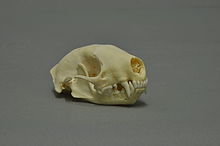シマスカンク (Mephitis mephitis 食肉目 スカンク科 スカンク属 に分類される哺乳類。スカンク属の模式種[ 2] [ 4] 北アメリカ (カナダ 南部、アメリカ合衆国 、メキシコ 北部)に分布[ 2]
尾を直立させた姿勢は臭液を噴射しようとするサインである。 シマスカンクの全身骨格 シマスカンクの頭蓋骨 頭胴長(体長)33-45cm[ 3] [ 2] [ 5] [ 5]
小さな円錐形の頭と長く重い毛皮で覆われた尾を持つ。体は頑丈な造りで、手足は短い[ 6]
毛皮の色とパターンは個体によって大きく異なるが、一般的には黒をベースに、白い筋が頭から尻と尾まで続く(白い筋は途中、肩で分かれる)[ 7] [ 5] [ 5] [ 8]
肢はむき出しの足裏をもつ板状で[ 5] ブタバナスカンク ほど広くも平らでもない[ 6] [ 5]
他のスカンク同様、捕食者を追い払うために、悪臭を放つ液体で満たされた臭腺を持つ。2つの発達した臭腺 を持ち、各15mlの臭液が入っている[ 9] [ 10] チオール の混合物で構成されており、数メートルの距離へ噴霧することができる。
温帯林、農地、市街地などに生息[ 7] [ 3] [ 11] [ 12] 猛禽類 を除いて、自然界の捕食者がほとんどいない[ 13]
毛皮のために捕獲され、また、飼育されて[ 11] [ 14] 低危険種 に分類されており、人為的に改変された環境にもよく適応している[ 1] [ 15] [ 7]
^ a b Helgen, K. & Reid, F. (2016). “Mephitis mephitis ” . IUCN Red List of Threatened Species 2016 : e.T41635A45211301. doi :10.2305/IUCN.UK.2016-1.RLTS.T41635A45211301.en . https://www.iucnredlist.org/species/41635/45211301 2022年10月1日 閲覧。
^ a b c d e f Julia Wade-Smith & B. J. Verts, “Mephitis mephitis
^ a b c 斉藤勝・伊東員義・細田孝久・西木秀人「イタチ科の分類」、今泉吉典監修『世界の動物 分類と飼育 2(食肉目)』東京動物園協会、1991年、42-46頁。
^ W. Christopher Wozencraft, “Order Carnivora ,” In: Don E. Wilson & DeeAnn M. Reeder (eds.), Mammal Species of the World (3rd ed.), Johns Hopkins University Press, 2005, Pages 532-628.
^ a b c d e f Rosatte, R. & Lawson, S. (2003). Skunks. In G. Feldhamer, B. Thompson, & J. Chapman (Eds.), Wild Mammals of North America; biology, management and conservation
^ a b Coues, E. (1877). Fur-bearing animals: a monograph of North American Mustelidae, in which an account of the wolverene, the martens or sables, the ermine, the mink and various other kinds of weasels, several species of skunks, the badger, the land and sea otters, and numerous exotic allies of these animals, is contributed to the history of North American mammals .
^ a b c ジュリエット・クラットン=ブロック(2005)『ネイチャー・ハンドブック 世界哺乳類図鑑』新樹者, 256-257頁
^ Seton, E. T. (1909). Life-histories of northern animals : an account of the mammals of Manitoba
^ Merriam, C. H. (1886). The mammals of the Adirondack region, northeastern New York. New York : Henry Holt and Co. pp. 69-87.
^ Berenbaum, M. R. (1995-01-03). “The chemistry of defense: theory and practice” (英語). Proceedings of the National Academy of Sciences 92 (1): 2–8. Bibcode : 1995PNAS...92....2B . doi :10.1073/pnas.92.1.2 . ISSN 0027-8424 . PMC 42807 . PMID 7816816 . https://www.ncbi.nlm.nih.gov/pmc/articles/PMC42807/ . ^ a b Lantz, D. E. (1923). Economic value of North American skunks
^ スミソニアン協会監修(2012)『世界博物学大図鑑』東京書籍, 574頁
^ Wade-Smith, J. & Verts, B. J. (1982). "Mephitis mephitis" (PDF). Mammalian Species 173 : 1–7.
^ Cipriani, D. (2011) "Skunks are affectionate, intelligent pets for owners who offer the proper care." Critters USA . pp. 2-6
^ Feinstein, J. (2011). Field Guide to Urban Wildlife . Stackpole Books. p. 67. ISBN 0811705854
Mephitis mephitis Viverra mephitis





